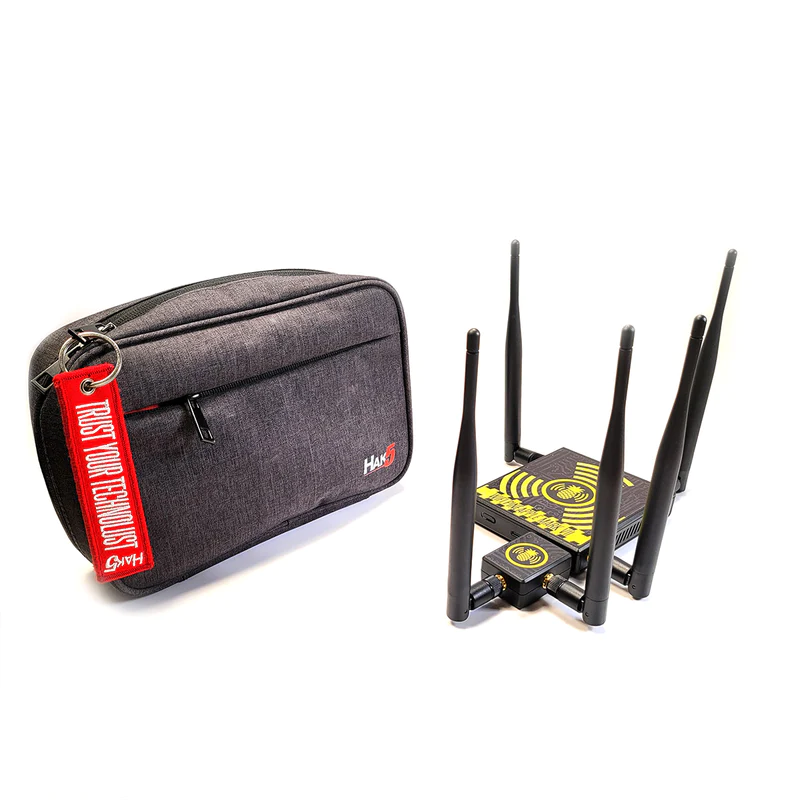The focus of this post is only on the hak5 wireless pineapple, but I’ve also created a great post on many wireless network pentesting tools here.

In the ever-evolving realm of cybersecurity, the significance of wireless network pentesting cannot be overstated. Among the array of tools available, the Hak5 WiFi Pineapple stands out as a beacon, empowering security professionals, ethical hackers, and enthusiasts to assess and fortify the security of wireless networks. This comprehensive exploration will delve into the intricacies of the Hak5 WiFi Pineapple, unraveling its features, applications, and its pivotal role in wireless network pentesting.
Understanding the Hak5 WiFi Pineapple:
The Hak5 WiFi Pineapple represents a purpose-built wireless penetration testing tool, meticulously crafted by the cybersecurity enthusiasts at Hak5. Tailored to simulate and assess the security of Wi-Fi networks, this device has become an indispensable asset for professionals engaged in wireless network pentesting. It is imperative to emphasize that the WiFi Pineapple is designated strictly for legal and ethical use, primarily intended for security testing and educational purposes.

Built to be a versatile and potent wireless penetration testing tool, the WiFi Pineapple leverages a robust tech stack that enables it to execute a myriad of functions crucial for assessing and fortifying wireless network security.
Hardware Components:
- Processor: At the heart of the WiFi Pineapple lies a powerful processor that provides the computational muscle for executing complex tasks. The processing capabilities are crucial for tasks such as packet inspection, deauthentication attacks, and the emulation of legitimate Wi-Fi networks.
- Wireless Interfaces: The device typically incorporates multiple wireless interfaces, allowing it to simultaneously perform various functions. These interfaces enable the creation of rogue access points, capture of wireless traffic, and active scanning for nearby Wi-Fi networks.
- Storage: WiFi Pineapple features onboard storage for storing configurations, captured data, and payloads. This storage is essential for maintaining the device’s settings, logs, and any additional modules or scripts that users may deploy.
- Power Supply: A reliable power supply ensures continuous operation. The WiFi Pineapple is designed to be portable, allowing security professionals to conduct wireless network pentesting in diverse environments.
Software Components:
- OpenWRT Operating System: The WiFi Pineapple utilizes the OpenWRT operating system as its foundation. OpenWRT, an open-source Linux distribution, provides a flexible and customizable environment. It allows for easy adaptation to specific requirements, making it an ideal choice for a device focused on wireless network pentesting.
- PineAP Suite: A proprietary suite developed by Hak5, PineAP is the core feature set responsible for emulating access points, deauthentication attacks, and actively capturing wireless client information. PineAP lays the foundation for creating realistic testing scenarios during wireless network pentesting.
- Web Interface: The intuitive web interface is a critical component that facilitates user interaction. It simplifies configuration, control, and monitoring, providing users—both seasoned professionals and beginners alike—with a user-friendly means of accessing and managing the device.
- Payload Modules: The WiFi Pineapple supports the deployment of payload modules—custom scripts or applications that extend its functionality. These modules automate specific tasks, such as DNS spoofing, credential harvesting, or creating captive portals. They contribute to the device’s adaptability and versatility in wireless network pentesting scenarios.
- Networking Tools: Various networking tools and utilities are integrated into the WiFi Pineapple, enabling tasks such as packet capturing, network reconnaissance, and analysis. These tools, combined with the PineAP suite, empower security professionals to gain deep insights into the security posture of wireless networks.
Development Frameworks and Languages:
- Bash Scripting: Bash scripts play a crucial role in the WiFi Pineapple’s operational logic. They provide the necessary automation for tasks such as configuring interfaces, initiating attacks, and managing captured data.
- Python: Python, being a versatile and widely used programming language, is often employed for developing modules and scripts that enhance the WiFi Pineapple’s functionality. Python’s readability and extensibility contribute to the ease with which developers can extend the device’s capabilities.
- JavaScript (for Web Interface): The web interface relies on JavaScript for dynamic and interactive user experiences. This client-side scripting language facilitates seamless communication between users and the device through the web interface.
Key Features of Hak5 WiFi Pineapple:
Diving deeper into the Hak5 WiFi Pineapple reveals a wealth of features meticulously designed to streamline wireless network pentesting. Let’s unravel these capabilities in more detail:
| Feature | Description |
|---|---|
| PineAP Suite | At its core, the PineAP suite empowers the WiFi Pineapple to mimic legitimate Wi-Fi networks, perform deauthentication attacks, and actively capture wireless client information. |
| Capture and Analysis | The device excels in capturing wireless traffic, analyzing it for potential vulnerabilities, and logging data such as Wi-Fi probe requests and SSID broadcasts. |
| PineAP Reconnaissance | This feature enables active scanning for nearby Wi-Fi networks, identifying SSIDs, BSSIDs, and other relevant information, aiding in understanding the Wi-Fi landscape. |
| Payload Modules | WiFi Pineapple supports the use of payload modules, extending its functionality with automated tasks such as DNS spoofing, credential harvesting, and creating captive portals. |
| Intuitive Web Interface | Equipped with a user-friendly web interface, the device simplifies configuration and operation, making it accessible to both experienced professionals and beginners. |
Applications of Hak5 WiFi Pineapple in Wireless Network Pentesting:
- Wireless Network Pentesting:
The Hak5 WiFi Pineapple takes center stage in wireless network pentesting. Security professionals leverage its capabilities to simulate attacks on Wi-Fi networks, identify vulnerabilities, and assess the effectiveness of existing security measures. - Security Awareness Training:
Beyond conventional applications, the WiFi Pineapple plays a pivotal role in security awareness training programs. Organizations harness its capabilities to demonstrate real-world Wi-Fi attacks, educating employees on secure Wi-Fi practices. - Research and Development:
For researchers and developers, the WiFi Pineapple serves as a sandbox for exploring and experimenting with various wireless security scenarios. It stands as a valuable tool for developing new security measures and contributing to overall improvements in wireless network security. - Educational Purposes:
Widely adopted in educational settings, the WiFi Pineapple enables students to gain hands-on experience in wireless security concepts, ethical hacking, and wireless network pentesting within a controlled environment.
Security Considerations and Ethical Use:
Ethical use of the Hak5 WiFi Pineapple is paramount to ensure legal compliance and maintain trust within the cybersecurity community. Responsible practices include:
- Obtain Proper Authorization:
Always secure explicit authorization before employing the WiFi Pineapple for wireless network pentesting. Unauthorized testing may lead to legal consequences. - Informed Consent:
When conducting security assessments, obtain informed consent from network owners or administrators. Clearly communicate the scope and purpose of testing to avoid misunderstandings. - Use in Controlled Environments:
Restrict the use of the WiFi Pineapple to controlled environments or those where explicit permission for testing has been granted. Avoid using it in public spaces without proper authorization. - Education and Training:
If used for educational purposes, emphasize responsible and ethical use of the WiFi Pineapple. Educate students on the legal and ethical considerations associated with wireless network pentesting.
Exploring WiFi Pineapple Capabilities:
A deeper exploration into the key capabilities of the Hak5 WiFi Pineapple unveils its prowess and versatility in wireless network pentesting:
- PineAP Suite:
The PineAP suite stands as the backbone of the WiFi Pineapple’s capability to simulate and assess Wi-Fi networks actively. It empowers the creation of rogue access points, deauthentication attacks, and the capturing of crucial wireless client information. - Capture and Analysis:
The device’s proficiency in capturing and analyzing wireless traffic is instrumental in identifying potential vulnerabilities. By logging data such as Wi-Fi probe requests and SSID broadcasts, security professionals gain profound insights into the behavior of devices attempting to connect to Wi-Fi networks. - PineAP Reconnaissance:
PineAP Reconnaissance actively scans nearby Wi-Fi networks, providing comprehensive information on SSIDs, BSSIDs, and other relevant details. This reconnaissance capability aids in mapping out the Wi-Fi landscape and identifying potential targets for security assessments. - Payload Modules:
The WiFi Pineapple’s support for payload modules enhances its versatility by allowing the automation of specific tasks. These modules can be customized to perform actions such as DNS spoofing, credential harvesting, or creating captive portals, streamlining the wireless network pentesting process. - Intuitive Web Interface:
The user-friendly web interface is a hallmark of the WiFi Pineapple, simplifying the configuration and operation process. Security professionals can seamlessly access and control various features, making it equally accessible to both seasoned users and those new to wireless network pentesting.
Code Integration Example:
import requests
def analyze_wifi_pineapple(network_name):
url = "https://pineapple-central-api.com/analyze"
api_key = "your_api_key_here"
params = {
"network_name": network_name,
"api_key": api_key,
}
response = requests.post(url, params=params)
return response.json()
# Example usage:
network_name = "example_network"
result_wifi_pineapple = analyze_wifi_pineapple(network_name)
print("WiFi Pineapple Analysis Result:", result_wifi_pineapple)In this example, the code showcases how to use the API of the WiFi Pineapple to analyze a specific network. Replace “your_api_key_here” with your actual API key.
Conclusion:
In conclusion, the Hak5 WiFi Pineapple emerges not just as a tool but as a cornerstone in the realm of wireless network pentesting. Its advanced features, ethical applications, and educational significance collectively position it as an invaluable asset for security professionals and enthusiasts alike. By comprehending its capabilities and deploying it responsibly, cybersecurity practitioners can not only fortify the security of wireless networks but also contribute to the creation of a safer digital landscape.
Leave a Reply